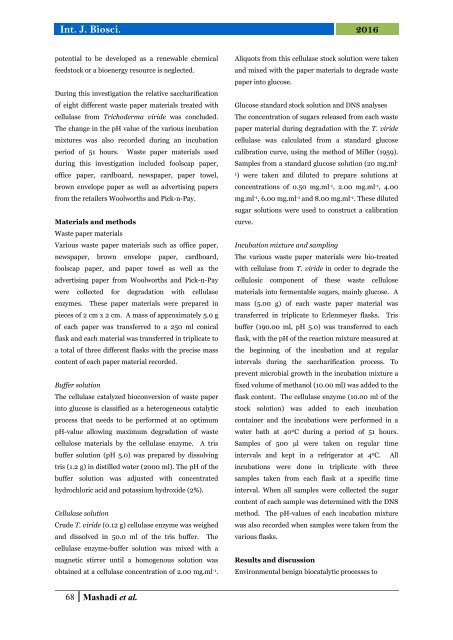Cellulas catalyzed bio conversion of different waste paper materials into ferment able sugars | By P. Mokatse
Cellulose catalyzed bio-conversion of different waste paper materials into ferment able sugars
Cellulose catalyzed bio-conversion of different waste paper materials into ferment able sugars
You also want an ePaper? Increase the reach of your titles
YUMPU automatically turns print PDFs into web optimized ePapers that Google loves.
Int. J. Biosci. 2016<br />
potential to be developed as a renew<strong>able</strong> chemical<br />
feedstock or a <strong>bio</strong>energy resource is neglected.<br />
During this investigation the relative saccharification<br />
<strong>of</strong> eight <strong>different</strong> <strong>waste</strong> <strong>paper</strong> <strong>materials</strong> treated with<br />
cellulase from Trichoderma viride was concluded.<br />
The change in the pH value <strong>of</strong> the various incubation<br />
mixtures was also recorded during an incubation<br />
period <strong>of</strong> 51 hours. Waste <strong>paper</strong> <strong>materials</strong> used<br />
during this investigation included foolscap <strong>paper</strong>,<br />
<strong>of</strong>fice <strong>paper</strong>, cardboard, news<strong>paper</strong>, <strong>paper</strong> towel,<br />
brown envelope <strong>paper</strong> as well as advertising <strong>paper</strong>s<br />
from the retailers Woolworths and Pick-n-Pay.<br />
Materials and methods<br />
Waste <strong>paper</strong> <strong>materials</strong><br />
Various <strong>waste</strong> <strong>paper</strong> <strong>materials</strong> such as <strong>of</strong>fice <strong>paper</strong>,<br />
news<strong>paper</strong>, brown envelope <strong>paper</strong>, cardboard,<br />
foolscap <strong>paper</strong>, and <strong>paper</strong> towel as well as the<br />
advertising <strong>paper</strong> from Woolworths and Pick-n-Pay<br />
were collected for degradation with cellulase<br />
enzymes. These <strong>paper</strong> <strong>materials</strong> were prepared in<br />
pieces <strong>of</strong> 2 cm x 2 cm. A mass <strong>of</strong> approximately 5.0 g<br />
<strong>of</strong> each <strong>paper</strong> was transferred to a 250 ml conical<br />
flask and each material was transferred in triplicate to<br />
a total <strong>of</strong> three <strong>different</strong> flasks with the precise mass<br />
content <strong>of</strong> each <strong>paper</strong> material recorded.<br />
Buffer solution<br />
The cellulase <strong>catalyzed</strong> <strong>bio</strong><strong>conversion</strong> <strong>of</strong> <strong>waste</strong> <strong>paper</strong><br />
<strong>into</strong> glucose is classified as a heterogeneous catalytic<br />
process that needs to be performed at an optimum<br />
pH-value allowing maximum degradation <strong>of</strong> <strong>waste</strong><br />
cellulose <strong>materials</strong> by the cellulase enzyme. A tris<br />
buffer solution (pH 5.0) was prepared by dissolving<br />
tris (1.2 g) in distilled water (2000 ml). The pH <strong>of</strong> the<br />
buffer solution was adjusted with concentrated<br />
hydrochloric acid and potassium hydroxide (2%).<br />
<strong>Cellulas</strong>e solution<br />
Crude T. viride (0.12 g) cellulase enzyme was weighed<br />
and dissolved in 50.0 ml <strong>of</strong> the tris buffer. The<br />
cellulase enzyme-buffer solution was mixed with a<br />
magnetic stirrer until a homogenous solution was<br />
obtained at a cellulase concentration <strong>of</strong> 2.00 mg.ml -1 .<br />
Aliquots from this cellulase stock solution were taken<br />
and mixed with the <strong>paper</strong> <strong>materials</strong> to degrade <strong>waste</strong><br />
<strong>paper</strong> <strong>into</strong> glucose.<br />
Glucose standard stock solution and DNS analyses<br />
The concentration <strong>of</strong> <strong>sugars</strong> released from each <strong>waste</strong><br />
<strong>paper</strong> material during degradation with the T. viride<br />
cellulase was calculated from a standard glucose<br />
calibration curve, using the method <strong>of</strong> Miller (1959).<br />
Samples from a standard glucose solution (20 mg.ml -<br />
1<br />
) were taken and diluted to prepare solutions at<br />
concentrations <strong>of</strong> 0.50 mg.ml -1 , 2.00 mg.ml -1 , 4.00<br />
mg.ml -1 , 6.00 mg.ml -1 and 8.00 mg.ml -1 . These diluted<br />
sugar solutions were used to construct a calibration<br />
curve.<br />
Incubation mixture and sampling<br />
The various <strong>waste</strong> <strong>paper</strong> <strong>materials</strong> were <strong>bio</strong>-treated<br />
with cellulase from T. viride in order to degrade the<br />
cellulosic component <strong>of</strong> these <strong>waste</strong> cellulose<br />
<strong>materials</strong> <strong>into</strong> <strong>ferment</strong><strong>able</strong> <strong>sugars</strong>, mainly glucose. A<br />
mass (5.00 g) <strong>of</strong> each <strong>waste</strong> <strong>paper</strong> material was<br />
transferred in triplicate to Erlenmeyer flasks. Tris<br />
buffer (190.00 ml, pH 5.0) was transferred to each<br />
flask, with the pH <strong>of</strong> the reaction mixture measured at<br />
the beginning <strong>of</strong> the incubation and at regular<br />
intervals during the saccharification process. To<br />
prevent microbial growth in the incubation mixture a<br />
fixed volume <strong>of</strong> methanol (10.00 ml) was added to the<br />
flask content. The cellulase enzyme (10.00 ml <strong>of</strong> the<br />
stock solution) was added to each incubation<br />
container and the incubations were performed in a<br />
water bath at 40 0 C during a period <strong>of</strong> 51 hours.<br />
Samples <strong>of</strong> 500 µl were taken on regular time<br />
intervals and kept in a refrigerator at 4 0 C. All<br />
incubations were done in triplicate with three<br />
samples taken from each flask at a specific time<br />
interval. When all samples were collected the sugar<br />
content <strong>of</strong> each sample was determined with the DNS<br />
method. The pH-values <strong>of</strong> each incubation mixture<br />
was also recorded when samples were taken from the<br />
various flasks.<br />
Results and discussion<br />
Environmental benign <strong>bio</strong>catalytic processes to<br />
68 Mashadi et al.


















